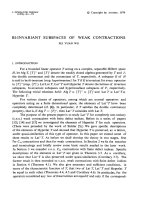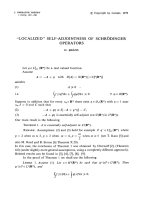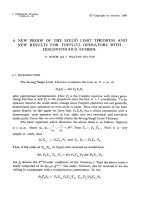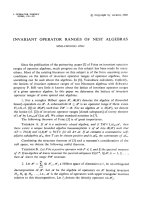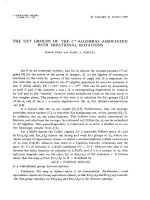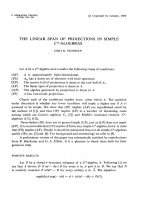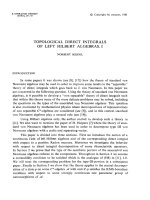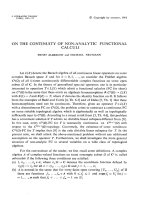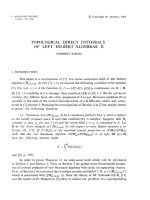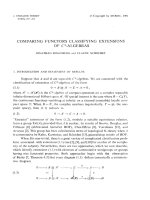Báo cáo toán học: " LONGEST INCREASING SUBSEQUENCES OF RANDOM COLORED PERMUTATIONS" pps
Bạn đang xem bản rút gọn của tài liệu. Xem và tải ngay bản đầy đủ của tài liệu tại đây (262.71 KB, 12 trang )
LONGEST INCREASING SUBSEQUENCES
OF RANDOM COLORED PERMUTATIONS
Alexei Borodin
Department of Mathematics, The University of Pennsylvania
Philadelphia, PA 19104-6395, U.S.A.
Submitted: February 7, 1999; Accepted: February 15, 1999.
We compute the limit distribution for the (centered and scaled) length
of the longest increasing subsequence of random colored permutations. The limit
distribution function is a power of that for usual random permutations computed
recently by Baik, Deift, and Johansson (math.CO/9810105). In the two–colored case
our method provides a different proof of a similar result by Tracy and Widom about
the longest increasing subsequences of signed permutations (math.CO/9811154).
Our main idea is to reduce the ‘colored’ problem to the case of usual random
permutations using certain combinatorial results and elementary probabilistic argu-
ments.
1. Introduction
Baik, Deift, and Johansson recently solved a problem about the asymptotic be-
havior of the length l
n
of the longest increasing subsequence for random permuta-
tions of order n as n →∞(with the uniform distribution on the symmetric group
S
n
). They proved, see [BDJ], that the sequence
l
n
− 2
√
n
n
1/6
converges in distribution, as n →∞, to a certain random variable whose distribution
function we shall denote by F (x). This distribution function can be expressed via
a solution of the Painlev´e II equation, see [BDJ] for details. It was first obtained
by Tracy and Widom [TW1] in the framework of Random Matrix Theory where it
gives the limit distribution for the (centered and scaled) largest eigenvalue in the
Gaussian Unitary Ensemble of Hermitian matrices.
1991 Mathematics Subject Classification. Primary 05A05, Secondary 60F99.
Typeset by A
M
S-T
E
X
1
2
The problem of the asymptotics of l
n
was first raised by Ulam [U]. Substantial
contributions to the solution of the problem have been made by Hammersley [H],
Logan and Shepp [LS], Vershik and Kerov [VK1, VK2].
A survey of the interesting history of this problem, further references, and a
discussion of its intriguing connection with Random Matrix Theory can be found
in [BDJ].
Soon after the appearance of [BDJ] Tracy and Widom computed the asymptotic
behavior of the length l
n
of the longest increasing for the random ‘signed permuta-
tions’, see definitions in the next section. In [TW2] they showed that
l
n
− 2
√
2n
2
2/3
(2n)
1/6
converges in distribution, as n →∞, to a random variable with the distribution
function F
2
(x).
The present paper provides another proof of the result by Tracy and Widom. In
our approach the distribution function F
2
(x) arises as the distribution function of
the maximum of two asymptotically independent variables each of which behaves
as (l
n
−2
√
n)/n
1/6
(hence, by [BDJ], converges to the distribution given by F (x)).
The combinatorial techniques we use relies on recent works by Rains [R] and
Fomin & Stanton [FS]. It also allows to handle a more general case of ‘colored
permutations’ (the problem for ‘two–colored case’, essentially, coincides with that
for signed permutations). We show that for the length l
n
of the longest increasing
subsequence of the random m–colored permutations of order n the sequence
l
n
− 2
√
mn
m
2/3
(mn)
1/6
converges in distribution, as n →∞, to a random variable with distribution function
F
m
(x). The function F
m
(x) naturally appears as the distribution function of the
maximum of m asymptotically independent variables, each having F (x) as the limit
distribution function.
Combinatorial quantities which we consider can be also interpreted as expecta-
tions of certain central functions on unitary groups, see Section 4.
I am very grateful to G. I. Olshanski for a number of valuable discussions.
2. Colored permutations and signed permutations
A colored permutation is a map from {1, ,n} to {1, ,n}×{1, ,m} such
that its composition with the projection on the first component of the target set is
a permutation (of order n). One can view such a map as a permutation with one
of m colors attributed to each of n points which this permutation permutes. The
setofallcoloredpermutationsofordern with m colors will be denoted by S
(m)
n
.
3
An increasing subsequence of π ∈ S
(m)
n
is a sequence 1 ≤ i
1
<i
2
< ···<i
k
≤ n
such that the first coordinates of π(i
j
)increaseinj and the second coordinates of
π(i
j
) are equal. Thus, elements of an increasing subsequence are of the same color,
say, p.Thelength of such increasing subsequence is defined to be m(k −1) + p.
These definitions are due to Rains [R]. A slightly more general notion of hook
permutation was introduced and intensively used earlier by Stanton and White [SW].
We shall consider S
(m)
n
as a probability space with uniform distribution: proba-
bility of each colored permutation is |S
(m)
n
|
−1
=(m
n
n!)
−1
. Then the length of the
longest increasing subsequence becomes a random variable on this space, it will be
denoted as L
col(m)
n
.
Let H
n
be the hyperoctahedral group of order n defined as the wreath product
n
2
S
n
(S
n
is the symmetric group of order n). The elements of H
n
are called
signed permutations. This group can be naturally embedded in S
2n
as the group
of permutations σ of {−n, −n +1, ,−1, 1, ,n− 1,n} subject to the condition
σ(−x)=−σ(x). Indeed, each such permutation is parametrized by the permutation
|σ|∈S
n
andthesetofsignsofσ(1), ,σ(n). Using the natural ordering on the
set {−n, −n +1, ,−1, 1, ,n− 1,n} we can define the length of the longest
increasing subsequence for each signed permutation. Assuming that every signed
permutation has probability |H
n
|
−1
=(2
n
n!)
−1
, we get a random variable on H
n
which will be denoted as L
even
n
.
The group H
n
canalsobeembeddedintothesymmetricgroupoforder2n+1: we
add 0 to the set {−n, −n +1, ,−1, 1, ,n−1,n} and assume that the elements
σ ∈ H
n
satisfy the same condition σ(−x)=−σ(x). Clearly, this implies σ(0) = 0.
TherandomvariableonH
n
equal to the length of the longest increasing subsequence
with respect to this realization will be denoted by L
odd
n
.
Note that for any element σ ∈ H
n
,
L
odd
n
(σ) − L
even
n
(σ)=0or1. (2.1)
3. Rim hook tableaux
We refer to the work [SW] for the definitions concerning rim hook tableaux.
The next claim is a direct consequence of the Schensted algorithm, see [S].
Proposition 3.1. Permutations of order n with the length of longest increasing
subsequence equal to l are in one–to–one correspondence with pairs of standard
Young tableaux of the same shape with n boxes and width l.
Here is a generalization of this claim for colored permutations.
Proposition 3.2 [R], [SW]. Colored permutations with m colors of order n with
the length of longest increasing subsequence equal to l are in one–to–one correspon-
dence with pairs of m–rim hook tableaux of the same shape with mn boxes and
width l.
4
In [SW] it was proved that
l
m
=
w
m
where w is the width of the rim hook
tableau corresponding to a permutation with the length of longest increasing sub-
sequence equal to l (a stands for the smallest integer ≥ a). The refinement of this
statement given above was published in [R].
Proposition 3.3 [R]. Signed permutations of order n embedded in S
2n
with the
length of longest increasing subsequence equal to l are in one–to–one correspondence
with pairs of 2–rim hook tableaux of the same shape with 2n boxes and width l.
The length of the longest increasing subsequence for signed permutations em-
bedded into the symmetric group of odd order can also be interpreted in terms of
rim hook tableaux, see [R, proof of Theorem 2.3].
Note that Propositions 3.2 and 3.3 imply that the distributions of random vari-
ables L
col(2)
n
and L
even
n
coincide.
4. Expectations over unitary groups
Everywhere below the symbol
U∈U(k)
f(U) stands for the integral of f over
U ∈ U(k) with respect to the Haar measure on the unitary group U(k) normalized
so that
U∈U(k)
1 = 1 (i.e., denotes the expectation of f with respect to the
uniform distribution on the unitary group).
Proposition 4.1 [R].
Prob{L
col(m)
n
≤ k} =(m
n
n!)
−1
·
U∈U(k)
|Tr(U
m
)
n
|
2
. (4.1)
Proposition 4.2 [R].
Prob{L
even
n
≤ k} =(2
n
n!)
−1
·
U∈U(k)
|Tr(U
2
)
n
|
2
. (4.2)
Prob{L
odd
n
≤ k} =(2
n
n!)
−1
·
U∈U(k)
|Tr(U
2
)
n
Tr(U)|
2
. (4.3)
[DS] gives (4.1) for k ≥ mn, (4.2) for k ≥ 2n,and(4.3)fork ≥ 2n +1. Forsuch
values of k the left–hand sides of (4.1), (4,2), (4.3) are all equal to 1.
5. Rim hook lattices
Our main reference for this section is the work [FS] by Fomin and Stanton.
For this section we fix an integer number m, all our rim hooks here will contain
exactly m boxes.
Let µ and λ be shapes (Young diagrams) such that µ ⊂ λ and λ −µ is a (m–)rim
hook. Then we shall write µ λ.
We introduce a partial order on the set of Young diagrams as follows: λ µ
if and only if there exists a sequence ν
1
,ν
2
, ,ν
k
of Young diagrams such that
5
µ ν
1
ν
2
··· ν
k
λ. The empty Young diagram is denoted by ∅.We
shall say that a Young diagram λ is m–decomposable if λ ∅.
The poset of all m–decomposable shapes with as the order is called rim hook
lattice and is denoted by RH
m
. (It can be shown that this poset is indeed a lattice).
For m =1wegettheYoung lattice: the poset of all Young diagrams ordered by
inclusion. The Young lattice will be denoted by .
Proposition 5.1 [FS]. The rim hook lattice RH
m
is isomorphic to the Cartesian
product of m copies of the Young lattice: RH
m
∼
=
m
.
In other words, RH
m
is isomorphic to the poset of m–tuples of Young diagrams
with the following coordinate–wise ordering: one tuple is greater than or equal to
another tuple if the kth coordinate of the first tuple includes (i.e., greater than or
equal to) the kth coordinate of the second tuple for all k =1, ,m.
Clearly, the number of m–rim hook tableaux of a given shape λ is equal to the
number of paths ∅ν
1
ν
2
···ν
k
λ, k = |λ|/m − 1, from ∅ to λ (and
isequalto0ifλ is not m–decomposable), |λ| stands for the number of boxes in λ.
We shall denote this number by dim
m
λ and call it the m–dimension of the shape
λ.
Take any λ ∈ RH
m
and the corresponding m–tuple (λ
1
, ,λ
m
) ∈
m
. Note
that |λ| = m(|λ
1
| + ···+ |λ
m
|). We have
dim
m
λ =
(|λ
1
|+ ···+ |λ
m
|)!
|λ
1
|! ···|λ
m
|!
·dim
1
λ
1
···dim
1
λ
m
. (5.1)
Indeed, to specify the path from ∅ to (λ
1
, ,λ
m
) we need to specify m paths from
∅ to λ
k
in the kth copy of for k =1, ,m together with the order in which we
make steps along those paths. The number of different orders is the combinatorial
coefficient in the right–hand side of (5.1) while the number of different possibilities
for the m paths in is the product of 1–dimensions dim
1
λ
1
···dim
1
λ
m
.
Note that the number of pairs of m–rim hook tableaux of the same shape λ is
exactly
dim
2
m
λ =
(|λ
1
| + ···+ |λ
m
|)!
|λ
1
|! ···|λ
m
|!
2
· dim
2
1
λ
1
···dim
2
1
λ
m
. (5.2)
Let us denote by w(λ) the width of a Young diagram λ. We shall need the
following
Observation 5.2. For any λ ∈ RH
m
and corresponding m–tuple (λ
1
, ,λ
m
) ∈
m
we have
m ·max{w(λ
1
), ,w(λ
m
)}−w(λ) ∈{0, 1, ,m− 1}. (5.3)
This follows immediately from the explicit construction of the isomorphism from
Proposition 5.1, see [FS, §2].
Observation 5.2 will be crucial for our further considerations.
6
6. Plancherel distributions
Using the correspondence from Proposition 3.2 (which is exactly the rim hook
generalization of the Schensted algorithm, see [SW]), we can associate to each m–
colored permutation of order n a Young diagram with mn boxes—thecommon
shape of the corresponding pair of m–rim hook tableaux. The image of the uni-
form distribution on S
(m)
n
under this map gives a probability distribution on m–
decomposable Young diagrams with mn boxes; the weight of a Young diagram λ is,
clearly, equal to (m
n
n!)
−1
· dim
2
m
λ. As a consequence, we get (cf. [FS, Corollary
1.6])
|λ|=mn
dim
2
m
λ = m
n
n!. (6.1)
Using the isomorphism of Proposition 5.1 we transfer our probability distribution
to the set of m–tuples of Young disgrams with total number of boxes equal to n.
Then by (5.2) we see that the probability of an m–tuple (λ
1
, ,λ
m
) ∈
m
with
|λ
1
| + ···+ |λ
m
| = n equals
Prob{(λ
1
, ,λ
m
)} =
1
m
n
n!
n!
|λ
1
|! ···|λ
m
|!
2
· dim
2
1
λ
1
···dim
2
1
λ
m
. (6.2)
This distribution will be called the Plancherel distribution.
Proposition 6.1. For any n =1, 2,
Prob{|λ
1
| = n
1
, |λ
m
| = n
m
; n
1
+ ···+ n
m
= n}
=
1
m
n
n!
n
1
! ···n
m
!
.
(6.3)
Proof. Direct computation. Using (6.1) for m = 1 and (6.2) we get
Prob{|λ
1
| = n
1
, |λ
m
| = n
m
; n
1
+ ···+ n
m
= n}
=
1
m
n
n!
|λ
k
|=n
k
k=1, ,m
n!
|λ
1
|! ···|λ
m
|!
2
· dim
2
1
λ
1
···dim
2
1
λ
m
=
1
m
n
n!
n!
n
1
! ···n
m
!
2
· n
1
! ···n
m
!=
1
m
n
n!
n
1
! ···n
m
!
.
7. Two lemmas from Probability Theory
We shall denote by
p
−→ convergence of random variables in probability, and by
D
−→ convergence in distribution.
7
Lemma 7.1 [B, Theorem 4.1]. Let random variables ξ, {ξ
n
}
∞
i=1
, {η
n
}
∞
i=1
satisfy
ξ
n
−η
n
p
−→ 0,ξ
n
D
−→ ξ.
Then
η
n
D
−→ ξ.
For m real random variables ξ
1
, ,ξ
m
we shall denote by ξ
1
× ξ
2
×···×ξ
m
a
m
–valued random variable with distribution function
F
ξ
1
×···×ξ
m
(x)=F
ξ
1
(x
1
) ···F
ξ
m
(x
m
).
Lemma 7.2. Let {ξ
(k)
n
}
∞
n=1
, k =1, ,m,bem>1 sequences of real random
variables convergent in distribution to random variables ξ
(1)
, ,ξ
(m)
, respectively.
Denote by B
(m)
n
the nth order m–dimensional fair Bernoulli distribution:
Prob{B
(m)
n
=(k
1
, ,k
m
)} =
1
m
n
n!
k
1
!···k
m
!
,k
1
+ + k
m
= n, k
i
∈{0, ,n}
0, otherwise
Then the sequence
ζ
n
= ξ
(1)
B
(m)
n,1
× ξ
(2)
B
(m)
n,2
×···×ξ
(m)
B
(m)
n,m
converges in distribution to ξ
(1)
× ξ
(2)
×···×ξ
(m)
.Inparticular,ξ
(1)
B
(m)
n,1
D
−→ ξ
(1)
.
Proof. The conditions ξ
(k)
n
D
−→ ξ
(k)
, k =1, ,m, are equivalent to the pointwise
convergence of distribution functions
F
ξ
(k)
n
(x) → F
ξ
(k)
(x).
We have
F
ζ
n
(x)=
k
1
+···+k
m
=n
k
i
=1, ,n
1
m
n
n!
k
1
! ···k
m
!
·F
ξ
(1)
k
1
(x
1
) ···F
ξ
(m)
k
m
(x
m
).
For m convergent number sequences {a
(k)
n
} with limits a
(k)
, k =1, ,m,the
sequence
c
n
=
k
1
+···+k
m
=n
k
i
=1, ,n
1
m
n
n!
k
1
! ···k
m
!
a
(1)
k
1
···a
(m)
k
m
converges to the product a
(1)
···a
(m)
,soweconclude,that{F
ζ
n
(x)} converges to
F
(1)
ξ
(x
1
) ···F
(m)
ξ
(x
m
) pointwise.
Lemma 7.2 implies that random variables ξ
(1)
B
(m)
n,1
,ξ
(2)
B
(m)
n,2
, , ξ
(m)
B
(m)
n,m
are asymptot-
ically independent as n →∞.
8
8. Asymptotics
Baik, Deift, and Johansson recently proved, see [BDJ], that the sequence
L
col(1)
n
−2
√
n
n
1/6
converges in distribution to a certain random variable, whose distribution function
will be denoted by F (x). This function can be expressed through a particular
solution of the Painlev´e II equation, see [BDJ] for details.
In this section we shall study the asymptotic behavior of L
col(m)
n
for m ≥ 2when
n →∞. Our main result is the following statement.
Theorem 8.1. For any m =2, 3, the sequence
L
col(m)
n
− 2
√
mn
(mn)
1/6
converges in distribution, as n →∞, to a random variable with distribution function
F
m
(m
−
2
3
x).
This result for m = 2 was proved by Tracy and Widom in [TW2]. Since the
distributions of L
col(2)
n
and L
even
n
coincide (see Section 3), we immediately get two
other asymptotic formulas.
Corollary 8.2 [TW2]. The sequence
L
even
n
− 2
√
2n
(2n)
1/6
converges in distribution, as n →∞, to a random variable with distribution function
F
2
(2
−
2
3
x).
Corollary 8.3 [TW2]. The sequence
L
odd
n
−2
√
2n
(2n)
1/6
converges in distribution, as n →∞, to a random variable with distribution function
F
2
(2
−
2
3
x).
Proof of Corollary 8.3. Relation (2.1) implies that with probability 1,
(L
odd
n
− L
even
n
)(2n)
−1/6
→ 0.
Since the convergence with probability 1 implies the convergence in probability, the
claim follows from Lemma 7.1 and Corollary 8.2.
9
Proof of Theorem 8.1. The proof will consist of 4 steps.
Step 1. Following Sections 3, 5, 6, we shall interpret L
col(m)
n
as a random variable
on the space of all m–tuples (λ
1
, ,λ
m
) of Young diagram with total number
of boxes equal to n supplied with the Plancherel distribution. Let us denote by
l
(n)
1
, ,l
(n)
m
the widths of the Young diagrams λ
1
, ,λ
m
:
l
(n)
k
= w(λ
k
),k=1, ,m.
Observation 5.2 implies that with probability 1
L
col(m)
n
− m ·max{l
(n)
1
, ,l
(n)
m
}
n
1/6
→ 0.
Hence, by Lemma 7.1, it is enough to prove that
Prob
m ·max{l
(n)
1
, ,l
(n)
m
}−2
√
mn
(mn)
1/6
≤ x
→ F
m
(m
−
2
3
x)
Our strategy is to prove that l
(n)
1
, ,l
(n)
m
are asymptotically independent, and
that each of them asymptotically behaves as L
col(1)
[n/m]
. Then Theorem 8.1 will follow
from the result of [BDJ] stated in the beginning of this section.
Step 2.
Prob
m ·max{l
(n)
1
, ,l
(n)
m
}−2
√
mn
(mn)
1/6
≤ x
=Prob
m · l
(n)
1
− 2
√
mn
(mn)
1/6
≤ x; ;
m ·l
(n)
m
−2
√
mn
(mn)
1/6
≤ x
=Prob
l
(n)
1
− 2
n/m
(n/m)
1/6
≤ m
2
3
x; ;
l
(n)
m
− 2
n/m
(n/m)
1/6
≤ m
2
3
x
.
Thus, it suffices to prove that
Prob
l
(n)
1
−2
n/m
(n/m)
1/6
≤ x
1
; ;
l
(n)
m
−2
n/m
(n/m)
1/6
≤ x
m
→ F (x
1
) ···F (x
m
). (8.1)
Step 3. Denote by n
(n)
i
the number of boxes in λ
i
, i =1, ,m.Thenn
(n)
1
+ ···+
n
(n)
m
= n. We claim that for all i =1, ,m
l
(n)
i
−2
n/m
(n/m)
1/6
−
l
(n)
i
− 2
n
(n)
i
(n
(n)
i
)
1/6
p
−→ 0. (8.2)
10
Proposition 6.1 implies that
Prob{n
(n)
i
= k} =
(m −1)
n−k
m
n
n
k
.
This means that n
(n)
i
can be interpreted as the sum ξ
1
+ ···+ ξ
n
of n independent
identically distributed Bernoulli variables with
Prob{ξ
j
=0} =
m −1
m
, Prob{ξ
j
=1} =
1
m
.
The central limit theorem implies that with probability converging to 1,
n
m
−
n
m
1
2
+ε
<n
(n)
i
<
n
m
+
n
m
1
2
+ε
for any ε>0. Hence,
n
m
1
3
− (n
(n)
i
)
1
3
<
n
m
1
3
−
n
m
±
n
m
1
2
+ε
1
3
=
n
m
1
3
1 −
1 ±
n
m
−
1
2
+ε
1
3
<const·
n
m
−
1
6
+ε
(8.3)
for sufficiently large n.
Similarly, we have
n
m
−
1
6
−(n
(n)
i
)
−
1
6
<
n
m
−
1
6
−
n
m
±
n
m
1
2
+ε
−
1
6
=
n
m
−
1
6
1 −
1 ±
n
m
−
1
2
+ε
−
1
6
<const·
n
m
−
1
2
−
1
6
+ε
<const·
n
m
−
1
2
−ε
(8.4)
if we choose ε<1/12.
The result of [BDJ] implies that L
col(1)
n
n
−
1
2
−δ
D
−→ 0 for any δ>0.
From Proposition 6.2 it follows that in the notation of Lemma 7.2
l
(n)
i
∞
n=1
=
L
col(1)
(B
(m)
n,1
)
∞
n=1
.
Applying Lemma 7.2 we see that
l
(n)
i
n
(n)
i
1
2
+δ
D
−→ 0,
11
which means that l
(n)
i
<
n
(n)
i
1
2
+δ
with probability converging to 1.
Since n
(n)
i
<n/m+(n/m)
1+ε
2
with probability converging to 1, we get that
l
(n)
i
<
n
m
+
n
m
1+ε
2
1
2
+δ
=
n
m
1
2
+δ
1+
n
m
−1+ε
2
1
2
+δ
<
n
m
1
2
+δ
+ const ·
n
m
δ+
ε
2
<const·
n
m
1
2
+δ
(8.5)
with probability converging to 1.
Making use of the relations (8.3), (8.4), (8.5), we now see that
l
(n)
i
−2
n/m
(n/m)
1/6
−
l
(n)
i
−2
n
(n)
i
(n
(n)
i
)
1/6
≤ l
(n)
i
n
m
−
1
6
−(n
(n)
i
)
−
1
6
+2
n
m
1
3
− (n
(n)
i
)
1
3
<const·
n
m
1
2
+δ
n
m
−
1
2
−ε
+ const ·
n
m
−
1
6
+ε
with probability converging to 1. Since the last expression converges to zero as
n →∞if δ<ε<1/6, the proof of (8.2) is complete.
Therelation(8.2)impliesthatwehaveasymptoticequivalenceoftwom–di-
mensional vectors
l
(n)
1
− 2
n/m
(n/m)
1/6
; ;
l
(n)
m
− 2
n/m
(n/m)
1/6
−
l
(n)
1
−2
n
(n)
1
(n
(n)
1
)
1/6
; ;
l
(n)
m
−2
n
(n)
m
(n
(n)
m
)
1/6
p
−→ 0.
(8.6)
Step 4. The random m–dimensional vector
ζ
n
=
l
(n)
1
−2
n
(n)
1
(n
(n)
1
)
1/6
; ;
l
(n)
m
− 2
n
(n)
m
(n
(n)
m
)
1/6
(8.7)
is obtained from m identical 1–dimensional random variables
ξ
(i)
n
=
L
col(1)
n
− 2
√
n
n
1/6
,i=1, ,m
by the procedure described in Lemma 7.2:
ζ
n
= ξ
(1)
B
(m)
n,1
× ξ
(2)
B
(m)
n,2
×···×ξ
(m)
B
(m)
n,m
(this follows from Proposition 6.1). Since sequences {ξ
(i)
n
} converge in distribution,
as n →∞, to a random variable with distribution function F(x) (this is the result of
[BDJ]), the sequence (8.7) also converges in distribution to a random variable with
the distribution function F (x
1
) ···F (x
m
). Then Lemma 7.1 and (8.6) conclude the
proof of (8.1).
12
References
[BDJ] J. Baik, P. Deift, and K. Johansson, On the distribution of the length of the longest
increasing subsequence of random permutations, Preprint, math.CO/9810105.
[B] P. Billingsley, Convergence of Probability Measures, John Wiley & Sons, 1968.
[DS] P. Diaconis, M. Shahshahani, On the eigenvalues of random matrices, J. Appl. Prob. 31
(1994), 49–61.
[FS] S. Fomin, D. Stanton, Rim hook lattices, St. Petersburg Math. J. 9 (1998), no. 5, 1007–
1016.
[H] J.M.Hammersley,A few seed lings of research, Proc. Sixth Berkeley Symp. Math. Statist.
and Probability, Vol. 1 (1972), 345–394.
[LS] B. F. Logan and L. A. Shepp, A variational problem for random Young tableaux, Advances
in Math. 26 (1977), 206–222.
[R] E.M.Rains,Increasing subsequences and the classical groups,Elect.J.ofCombinatorics
5#R12(1998).
[S] C. Schensted, Longest increasing and decreasing subsequences,Canad.J.Math.13 (1961),
179-191.
[SW] D. W. Stanton, D. E. White, A Schensted Algorithm for rim hook tableaux, Journal of
Combinatorial Theory, Series A 40 (1985), 1985.
[TW1] C.A.TracyandH.Widom,Level–spacing distributions and the Airy kernel, Comm. Math.
Phys. 159 (1994), 151-174.
[TW2] , Random Unitary Matrices, Permutations, and Painlev´e, Preprint, math.CO/
9811154.
[U] S.M.Ulam,Monte Carlo calculations in problems of mathematical physics,inModern
Mathematics for the Engineers, E. F. Beckenbach, ed., McGraw–Hill (1961), 261-281.
[VK1] A.M.VershikandS.V.Kerov,Asymptotic behavior of the Plancherel measure of the
symmetric group and the limit form of Young tableaux,SovietMath.Dokl.233 (1977),
527–531.
[VK2] , Asymptotic behavior of the maximum and generic dimensions of irreducible rep-
resentations of the symmetric group, Functional Anal. Appl. 19 (1985), no. 1, 21–31.
